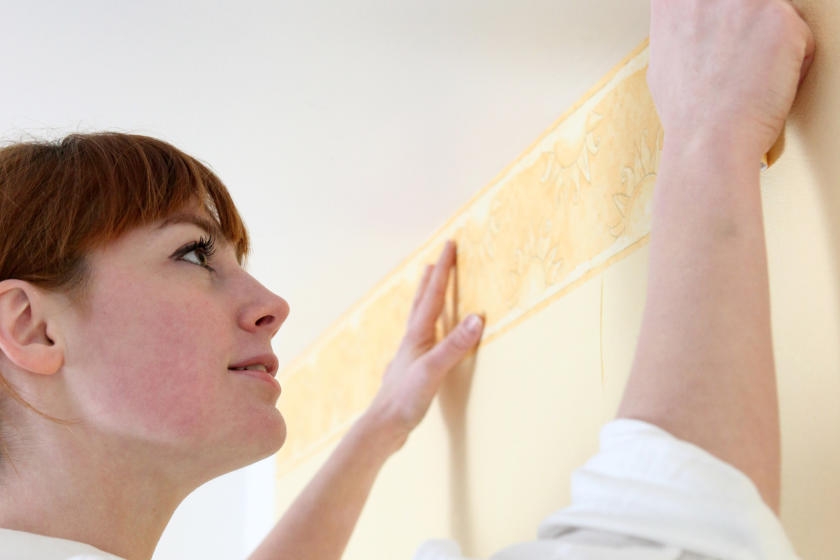If you want to get creative when updating a room, try adding wall borders as an accent. Decorative stencils or papered borders are a clever and inexpensive way to give your walls a new look.
Create a Border with Paint

Step 1: Plan Out Your Design
There are a couple of ways to paint a border. You can paint the wall with solid colors or use stencils to create a border design.
For solid borders, there are two common approaches. If you don’t have crown molding, a border can look good where the wall meets the ceiling, creating a nuanced division between the two. Borders are also often painted at, or a little higher or lower than, the middle of the wall. This creates a two-tone wall effect and can look similar to wainscoting. How you create your border though is a matter of your personal taste and imagination.
Whether you’re adding a border to an existing paint color or repainting an entire wall with a border in mind, learn how to use different colors to create the effect you want. It’s common to choose two shades of the same color, but you don’t have to limit yourself. For a bolder effect, try contrasting colors that complement one another.
Your local True Value hardware store’s Certified Color Experts can answer any questions you have about paint color and point you in the right direction, based on your preferences. Pick up a Custom Mixed Color Sample to try out different colors on your walls. You can also pick up one of our helpful Idea Cards or Trend Cards to help you choose your palette.
Stencils are typically available at decorating and craft stores or for a more custom design, you can create your own following these steps. First, find a design you like from a design or wallpaper sample book. Using a copy machine, enlarge or reduce the design as needed. Then, using a marking pen, trace the design onto a 7-mil Mylar sheet or clear plastic or use the copier to transfer your design onto clear acetate. Because acetate and Mylar stencils are transparent, they enable you to see the previously applied colors. This makes it easier to align the pattern as you move the stencil along the surface.
Make extra copies if you are making a separate stencil for each color. This will also let you bend or cut the stencil as needed at corners. Use a craft knife to carefully cut out the image to create a template. Stack the stencils together and use a hole punch to create registration marks (see Step 4) in each corner of the stencil. These act as a guide to keep your design consistent.

Helpful Tip
Bring room measurements and fabric samples with you while shopping for stencils and paints. This will keep your interior design consistent and ensure that your colors and pattern complements your existing décor.
Step 2: Outline the Border
To mark where you want the border to be placed you’ll need a yardstick, a level and a pencil. If you are creating a border along the middle of the wall, measure up from the floor about 36″ to 40″ and place a mark on the wall. With one hand, hold the yardstick horizontally against that mark. Use your other hand to place a level along the yardstick. Adjust the yardstick until it’s level, and trace a line with your pencil along the top of the yardstick. Continue creating this line in the same way across the length of the wall. A typical border at the wall/ceiling joint will be 6″ to 12″ wide.
Place painter’s tape along your pencil lines. Score the outer edge of the tape with your fingernail or the dull edge of a small knife so the paint will not bleed under the tape.
If you’re using a stencil, follow a similar process. By aligning your stencil on a guideline, you’ll keep your lines straight and parallel to the ceiling and trim. If, for example, you want the bottom of the stencil border to be 12″ below the ceiling line, measure down 12″ from each corner and make a mark. Make additional marks on the wall as needed, and use a pencil, yardstick and level to very lightly make a guideline. Apply painter’s tape outside the line, or below where the bottom of your stencil will be.
Safety Alert!
If you’re working near the ceiling, use a sturdy ladder, stepstool or low scaffold. Do not use chairs or other potentially unstable structures.
Step 3: Prepare the Room
Clean the walls with warm, soapy water and a cloth. Let the surface dry for at least an hour before painting. It’s best to move furniture out of the room, but if you can’t, just move it away from the walls and cover with canvas drop cloths or tarps.
Helpful Tip
Canvas drop cloths stay in place better than plastic ones.
Lay drop cloths below the walls you’re painting. Use masking tape to attach them to the baseboard or bottom of the wall so that they don’t shift around while you’re painting — this will reduce the chance of getting paint on your floor. Remove any fixtures and hardware on the walls.
Safety Alerts!
Always paint in a well-ventilated area. Open the windows to make sure you’ll have proper ventilation.
Wear goggles, protective gloves and protective clothing when painting.
Step 4: Paint
If you’re painting a solid-color border, start by using a large paintbrush or small roller and apply a coat of EasyCare Ultra Premium Interior Paint within the lines of painter’s tape, taking care not to paint over the tape too much. Use a small, angled paintbrush for any detail work or near corners. Allow the paint to dry completely for at least 24 hours. Apply a second coat if needed.
If working with stencils, spray mounting adhesive onto the back of the stencil and carefully align it with the guide marks you made. Place a small piece of masking tape on the surface under the registration marks. With continuous designs, you can start in any corner. If you’re using a non-continuous design, plan each wall separately so the pattern stops equidistant from the ends. Center the first stencil or place it to the left or right of the centerline, whichever produces the best result.
You need to plan carefully if you are bordering a window or door. The design will need to be mitered (cut at a 45-degree angle), just like the corner of a picture frame. You want this “cut” to be made in a relatively open area in the design so any mismatch is less noticeable. Test your plan by tracing it on paper.
Using a small paintbrush with firm bristles, hold your stencil brush close to the head. Dip the brush bristles in paint and then dab or swirl it on a paper towel to evenly distribute the paint across the tips of the bristles. You don’t want to overload your brush, so use minimal paint. Start from the outside and work in toward the center of the design. Do not paint outward, as this could cause your brush to catch the edge and push paint underneath the stencil. Stay vigilant about keeping the stencil’s bottom side clean. Clean your stencils between placements with a damp cloth so you don’t smudge your design.
Helpful Tip
If you want solid colors, consider using a mini foam paint roller, rolling out a little of the paint on paper before you roll the surface.
Carefully peel the stencil off the wall and clean off any paint. Reposition the stencil on your guideline so that the registration mark aligns with the previous registration mark. If you move to the left, the right-hand registration marks will align with the left-hand registration marks.
Border with Wallpaper

Step 1: Prepare the Room
As with painting, you need to prepare the room before you start applying a wallpaper border. Any furniture in the room should be removed or moved to the center of the room and covered with drop cloths. Cover flooring with drop cloths for protection from spills. Remove any fixtures and hardware on the walls. Also, remove any existing wallpaper from your walls using a wallpaper scraper tool and a liquid wallpaper stripper.
Step 2: Take Measurements
Measure the perimeter of your room with a tape measure first to see how much border you will need. Using a ruler or a yardstick, measure down from the ceiling to where you want the top of the border to be and place a pencil mark on the wall. Then hold up a level to this mark and trace a horizontal line along the wall. Continue this process, around the room to create a guideline. This will ensure that you hang the paper level and straight.
Step 3: Prepare the Border
Submerge the end of the border in a water tray. Slowly unroll the strip into the water and run it through the tray. Once the entire piece is in the water, pull it out and let it drip over the tray for a couple of seconds. Lay the paper on a table and fold the ends in so that glue is touching glue. This is called “booking” the wallpaper, and it gives the glue time to activate. Once the ends are folded in, fold the new ends into the center again, taking care not to crease the paper.
Helpful Tip
Keep your work surface as clean as possible so glue does not get on the front side of the paper.
Step 4: Apply Wallpaper Border
Use a stepladder to reach the ceiling. If you have a pattern that needs to be matched up, begin hanging your border in a corner. Hold the wallpaper at the horizontal line you drew and when it is centered, press the paper down. Smooth the rest of the paper onto the wall, using a smoothing brush or smoothing knife. Start from the ceiling down and from the center out. This will force out any air bubbles.
Wipe the wallpaper border with a clean damp sponge to remove any glue residue and to continue to remove any air bubbles. Make sure you rinse the sponge after each wipe. If you don’t rinse it thoroughly, you could spread glue along the wallpaper. Glue spots are quite noticeable when they dry and difficult to remove.
To make your border fit crisply and evenly in corners, smooth the paper into each corner with a smoothing knife. Then, carefully trim off excess paper with a utility knife.
Step 5: Clean Up
Double-check that there is no adhesive on the wallpaper border. Clean your tools with soap and water and throw away all the scrap wallpaper that you cannot use. Once the room is finished, you can replace your furniture, fixtures and hardware and re-hang any decorations.
Great job! You’re done. Your room looks refreshed and vibrant with its new border accent.
Project Shopping List
Here’s what you’ll need to complete this project successfully.
- EasyCare Ultra Premium Interior Paint
- 7-mil Mylar sheet
- Clear plastic file folder
- Clear acetate
- Marking pen
- Craft knife
- Hole-punch
- Yardstick
- Level
- Pencil
- Tape measure
- Painter’s tape
- Ladder
- Step-stool
- Low scaffold
- Cloth
- Canvas drop cloths
- Masking tape
- Tarps
- Safety goggles
- Protective gloves
- Protective clothing
- Large paintbrush
- Roller applicator
- Paint tray
- Small, angled paintbrush
- Mounting adhesive
- Small, firm-bristled paintbrush
- Mini foam paint roller (optional)
- Water tray
- Paper towels
- Screwdriver
- Wallpaper scraper
- Liquid wallpaper stripper
- Utility knife
- Smoothing brush or knife
- Sponge












